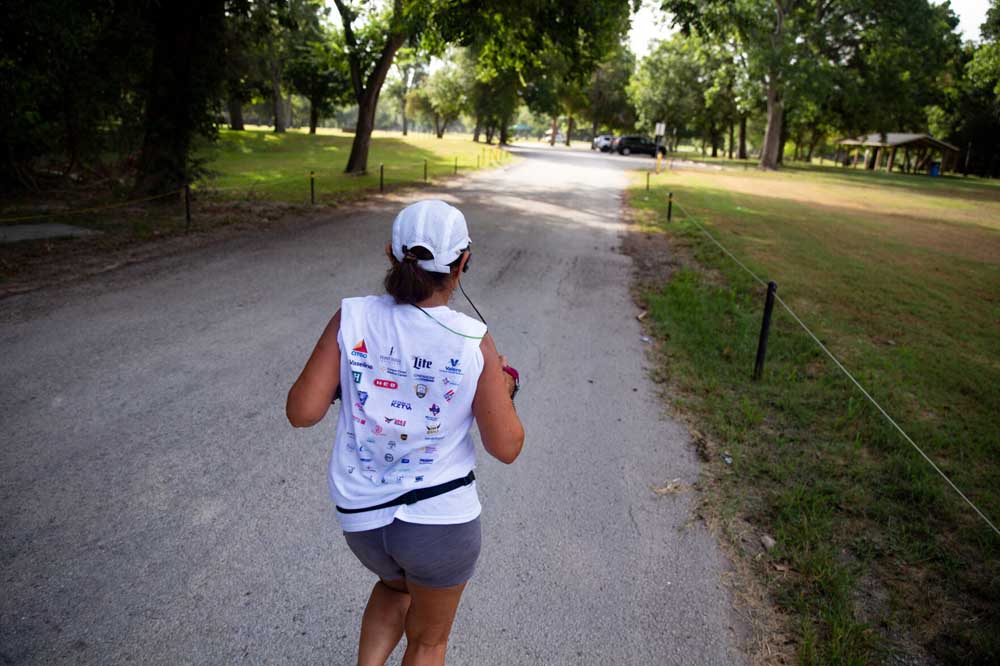Woman, 58, to take second shot at Texas’ hottest 100-miler
Published 9:25 am Friday, July 28, 2023

- Elizabeth Perez runs on her route to train for the “Texas Hottest Hundred Mile Race” ultramarathon on July 21 at Riverside Park.
One hundred miles is a relatively lengthy distance. In a car, it’s about an hour and half drive. An average bicycler might take eight hours to travel that far. For one to run that far, in the August Texas sun, is surely a feat.
It’s even more impressive for someone like 58-year-old Elizabeth Perez, who is preparing to run her fourth 100-miler on Aug. 12-13, in the “Habañero Hundred” in Cat Spring, Texas’ hottest ultra run.
Trending
She didn’t complete the race last year. “It’s a redemption run,” Perez said. “I need to finish, I desperately want to finish my first 100-miler.”
Perez has indeed completed two other 100-mile runs since then, but at last year’s Habañero, she tapped out at mile 75.
“I have to come back strong,” she said.
Races like the Habañero are often set for two days. Runners must take breaks, especially in conditions like Perez will face next month. In races like these, finish times can vary from 12-30 accumulated hours of running.
Head of business group has another title: Marathoner
In her first attempt, Perez said she did not have a pacer, someone tasked with running along with her to help her keep pace, motivation and focus. Multiple pacers often work in shifts with runners during races like these.
Trending
Moe Villanueva, a friend of Perez, will be one of those pacers for her at the Habañero.
“By the time she gets to me she’ll be on mile 60,” Villanueva said. “I try and make sure to put (runners) in a good mood, you know, because by then they’re not going to be in the best mood.”
Villanueva, 38, met Perez at a previous race and is an avid distance runner himself, completing in multiple 100-mile runs. He said working with Perez gives him motivation, as does seeing other runners in her age group at ultra races.
“I think it’s amazing, that’s why I love this sport,” he said. “When I see (older) people doing it kind of motivates me. You know? Like I still got a lot more years in me.”
Perez said running became a big part of her life in her early 40s. The positive health benefits are big plus for her, but as she competes in more and more serious runs, she says the positive mental effects and sense of accomplishment intensify.
“It does so much for you,” Perez said. “I feel like it’s just opened up a new chapter in my life.”
In prep for the upcoming grueling race, Perez tries to simulate the terrain of the Habañero. Victoria residents might spot her in late mornings on trails in Riverside Park, the area’s best substitute for the sandy course she’ll face in August. In races and training, she wears the usual runners garb, like a bright-colored vest, runner’s belt and a watch to keep pace.
But on race-day, Perez wears something else, something she’ll tell you is symbolic of what she carries with her during these monumental feats.
“I’m the only one in the family that’s running,” Perez said. “This is long and it’s hard. And I carry a lot with me when I do it. I’m carrying my sister’s illness.”
Hundreds of runners to raise money for local cancer patients with Victoria race
Pinned to her vest is a photo that reads “Running for Sylvia,” Perez’s sister. Sylvia, her older sister, lives in Houston and has Alzheimer’s disease. Perez said she is not doing well, which is a weight she carries in every race. The photo is a reminder that although Perez’s sister is not with her physically during an ultra race, she’s with her in mind and spirit.
Runners like Perez need these extra motivators to make it to the finish in these long, strenuous treks. Serious dangers can often lie on the course of 100-mile runs. Texas brings more than just heat, like the startle of a snake lying on the course — something Perez said has given her a jump scare on occasion during runs.
Still, the conditions are the biggest danger. Runners can succumb to heat-related illness or dehydration. Some even pass away, like Perez said one man did at least year’s Habañero of a heart attack, another reason why running with pacers is important for many.
With pitfalls like these, reaching the finish line in a 100-mile race can bring pure elation, especially for a runner in her late 50s like Perez. Looking forward to that moment on Aug. 13, Perez knows she’ll be overcome with emotion, if she indeed is able to complete her “redemption run” one year after falling short.
“At every end of my big races, I cry,” Perez said. “I’m crying when I see that finish line coming up. … Even now I’m crying, because this is just a really important race to me.”





